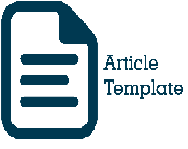Format
-
Article should at least consist of these parts: Introduction, Literature Review and Hypothesis Development (only literature review for qualitative research), Research Method, Result and Analysis, Conclusion and Reference. Acknowledgement (if any) should be placed after the Conclusion and before the Reference.
-
Article must be written on A4 paper size with 12pt font size and single line spacing, except for direct quotation. Direct quotation should be typed using single line spacing and in indented style.
-
Page margin should at least 2.5 cm for all sides (top, bottom, left and right).
-
Article should be written efficiently in approximately 4000-10.000 words.
-
Authors are encouraged to use Mendeley sofware for citation and reference.
Structure of Article
-
Title, written in English. Title should consist of no more than 12 words.
-
Abstract, are written preferably from 150-250 words and needs to be written in both English and Indonesian. Abstract should provide summary of purpose of the article, method, result and conclusion. Abstract should also be followed by keywords of 3-5 words in order to help preparing the article index.
-
Introduction, provides explanation of research background, purpose of the research, and research contribution.
-
Literature Review and Hypothesis Development, contains previous literatures related to the research and explains the hypothesis development.
-
Research Method, describes research plan or research design, research object and target (population and sample), technique in collecting research data, research model, and technique used for analysis.
-
Result and Analysis, presents result of data analysis, hypothesis testing, answer of research question, as well as finding and its interpretation.
-
Conclusion, describes the research conclusion, limitation of the research, and suggestions for conducting future research.
-
Reference, lists all sources used for writing the article.
Table and Figure (Graph)
-
Table and figure should be efficiently presented (only for table and figure with the result of data) and are placed on the article.
-
Table and figure must be numbered in sequence and be given a title that reflects its contents.
-
Reference of table and figure must be mentioned on the article.
-
Author should mention on the article where table and figure are attached.
-
Table and figure should be able to be interpreted without referring to the article.
-
Source of table and figure should also be presented.
-
Figure must be prepared in a printable version.
Citation
Citation apply the APA style. Citation on text is written between open and close parenthesis mentioning author’s surname, year with comma, and page number if necessary.
-
One source of citation with one author: (Wati, 2018); two authors (Schumacker & Lomax, 2010); more than two authors: (Krishnan et al., 2012); more than one source of citation with different authors: (Braun & Davis, 2003; Manson, 2001); more than one source of citation with similar author: (Djakman 1998, 2000).
-
When citation is accompanied with page number: (Collier, 2009, p. 6).
-
When referring to author with more than one article in the same year, use letter a, b, … after year on citation, e.g. (IAPI, 2015a, 2015b, 2015c).
-
When author’s name is mentioned on the text, the name does not have to be mentioned on citation, e.g. “Widuri (2014) found …”
-
Source of citation from an institution’s work should mention the acronym of the institution, e.g. (Badan Pemeriksa Keuangan, 2018).
Reference
Article should contain reference (only for source of citation) that is sorted alphabetically using author’s surname or institution’s name, e.g.:
Book
One Author
Wati, L. N. (2018). Metodologi Penelitian Terapan: Aplikasi SPSS, EVIEWS, Smart PLS dan AMOS. (Momon, Ed.) (Edisi Revi). Bekasi: Pustaka Amri.
Two to Four Authors
Schumacker, R. E., & Lomax, R. G. (2010). A beginner’s guide to structural equation modeling (3rd Editio). New York & London: Taylor and Francis Group, LLC.
Institutional Author
Badan Pemeriksa Keuangan. (2018). Laporan Tahunan Badan Pemeriksa Keuangan (BPK 2017). Jakarta: Divisi Penerbitan BPK.
Journal
Willborn, W. (1989). Quality Audits and Technological Excellence. International Journal of Quality & Reliability Management, 6(4), 19–26.
Lin, C.-W., & Wang, C.-H. (2011). A selection model for auditing software. Industrial Management & Data Systems Managerial Auditing Journal Iss Managerial Auditing Journal, 111(2), 776–790.
Widuri, R., O’Connell, B., & Yapa, P. W. S. (2016). Adopting generalized audit software: an Indonesian perspective. Managerial Auditing, 31(8/9), 821–847
Website
Australian Bureau of Statistics. (2000). 1996 Census of Population and Housing: Northern (Statistical Division) Queensland. Downloaded on 19 August 2001, http://www.abs.gov.au.
Workshop/Seminar
Darono, A. (2014). Penerapan “e-Audit” dalam Pemeriksaan Keuangan Negara: Tinjauan Dualitas Teknologi. In Seminar Nasional Aplikasi Teknologi Informasi 2014, At Islamics University of Indonesia Yogyakarta (pp. A1–A6). Yogyakarta: Islamics University of Indonesia.
Thesis/Dissertation/Working Paper
Widuri, R. (2014). Adoption and Use of Generalized Audit Software by Indonesian Audit Firms. Ph.D Dissertation, RMIT University.
Footnote
Footnote is only applied to give description or additional analysis, which when combined into a manuscript would disrupt manuscript’s continuity. Therefore, footnote is not used for reference. Footnote should be given serial numbers and be indicated by superscript figures. Text from footnote is placed on page with the superscript figures.










